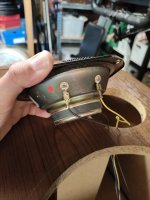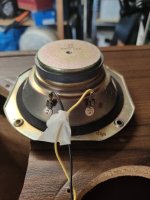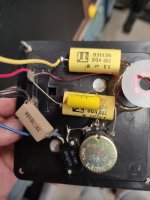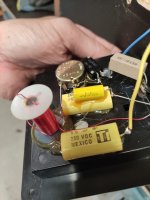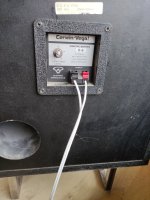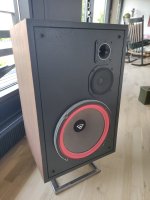Restoring a pair of cerwin vega d6-e's
Found out that the midrange drivers polarity was reversed, meaning: not the same in each speaker.
Cant find any diagrams online. Does anyone know, wich is the correct wiring?
Found out that the midrange drivers polarity was reversed, meaning: not the same in each speaker.
Cant find any diagrams online. Does anyone know, wich is the correct wiring?
Attachments
Not being able to see the complete picture, I can only suggest that the correct midrange driver polarity is the one that sounds best to your ears.
If I were choosing the colour coding, black wire would be my choice for connecting to the negative terminal - but that's just me!
If I were choosing the colour coding, black wire would be my choice for connecting to the negative terminal - but that's just me!
Correct polarity is such that there is no dip in crossover frequency due to cancellation.
To measure is to know.
http://www.troelsgravesen.dk/Inverted-Polarity.htm
To measure is to know.
http://www.troelsgravesen.dk/Inverted-Polarity.htm
Check the other ends of the wires, maybe those are reversed also.
Also, use a 1 5v battery to double check the markings. plus to plus moves the cone towards the listener.
Btw, it would be very common to have the mid inverted relative to the woofer and tweeter
Btw, it would be very common to have the mid inverted relative to the woofer and tweeter
The Mid-Range is connected with reverse polarity on purpose. This avoids phase cancellation that would result in a big dip in the frequency response at crossover. I have the schematic for the D3 & D5 crossovers, but not the D6, which is quite rare.
If you can draw a schematic of the crossover we may be able to guess which polarity would be correct. You just have to trace parts connected from the input terminals going to the drivers.
FWIW, here is the D3/D5 Crossover schematic. Note the straight wired woofer and reverse polarity on the midrange. Cerwin Vega speakers can thump pretty hard, but they were not known for their crossovers. Information on the D6 is scarce. Can you post pictures of the speaker, front and back, plus the crossover?
Attachments
I love Cerwin-Vega products in general. However, their configuration control left something to be desired. The D7 crossover had at least two versions and I hear that the D9 had more than five. You will notice C-V used as many common parts as possible, especially the crossovers, midrange and tweeters. I wish that I still had mine- would love to run up the enclosure and drivers with DATS. The C-V crossovers are sub-optimal in my opinion. A correctly redesigned crossover could make the speaker much smoother. My two cents.
Thanks for the replies 😊
I was planning on a better crossover. I think that there is "a lot going on" with the woofer, connected straight to the terminals😳
But it is hard to find specs of the drivers, so dont really know where to start, with a better crossover?
Som far i have upgraded the cable gauge, bypassed the "security switch" on the tweeter.
I prefer the tweeter pot, rolled all the way back, to minimum treble.
They sound "all right" - (better crossover perhaps)
The look better now, though😉. The vinyl had partially come off...so i veneered them with walnut veneer.
I was planning on a better crossover. I think that there is "a lot going on" with the woofer, connected straight to the terminals😳
But it is hard to find specs of the drivers, so dont really know where to start, with a better crossover?
Som far i have upgraded the cable gauge, bypassed the "security switch" on the tweeter.
I prefer the tweeter pot, rolled all the way back, to minimum treble.
They sound "all right" - (better crossover perhaps)
The look better now, though😉. The vinyl had partially come off...so i veneered them with walnut veneer.
Would adding a simple, first order, low pass filter, to the woofer, make sense?
Or is it crucial, to redesign the crossover completely?
Or is it crucial, to redesign the crossover completely?
I wouldn't be overconcerned about the lack of an electrical low pass filter on the woofer.
The very large woofer is likely to have its own natural roll-off at a frequency that integrates adequately with the midrange driver's band pass filter.
If you wish to experiment, I suggest you initially limit yourself to noting the effect of a small value inductor placed in series with the woofer.
The very large woofer is likely to have its own natural roll-off at a frequency that integrates adequately with the midrange driver's band pass filter.
If you wish to experiment, I suggest you initially limit yourself to noting the effect of a small value inductor placed in series with the woofer.
Most audio people have their own opinions on speakers. Crossovers seem to be a fairly contentious area. The JBL L100, one of the biggest selling speaker of all time, used a minimalist crossover- two caps and two L-Pads. . . And the resulting frequency response rose with higher frequencies with several big peaks and valleys. And . . . JBL sold thousands.
6 dB/Octave crossovers are subject to in-band resonances. They simply do not perform as you would expect (or calculate). In the case of the woofer, a series inductor will form an inductive voltage divider, not a filter. Any chance of success with the woofer would require a Zobel to flatten the impedance, so a calculated 12 dB/Octave has a decent chance of working. You need to find out if your woofer is 4 or 8 ohms. For an 8 Ohm speaker, a generic Zobel would be 22uF in series with a 8 or 10 Ohm resistor across the woofer terminals. You can tweak the values if you want to play, but remember the series resistance of the coil and wiring will affect the final value. Also, the Zobel resistor should be rated for at least on half of the rated woofer power.
Do you or a friend have access to a DATS measurement system? They are fairly inexpensive at $129.95 @ Parts Express. To do a proper crossover you need the driver parameters.
6 dB/Octave crossovers are subject to in-band resonances. They simply do not perform as you would expect (or calculate). In the case of the woofer, a series inductor will form an inductive voltage divider, not a filter. Any chance of success with the woofer would require a Zobel to flatten the impedance, so a calculated 12 dB/Octave has a decent chance of working. You need to find out if your woofer is 4 or 8 ohms. For an 8 Ohm speaker, a generic Zobel would be 22uF in series with a 8 or 10 Ohm resistor across the woofer terminals. You can tweak the values if you want to play, but remember the series resistance of the coil and wiring will affect the final value. Also, the Zobel resistor should be rated for at least on half of the rated woofer power.
Do you or a friend have access to a DATS measurement system? They are fairly inexpensive at $129.95 @ Parts Express. To do a proper crossover you need the driver parameters.
- Home
- Loudspeakers
- Multi-Way
- Reversed polarity on midrange drivers
